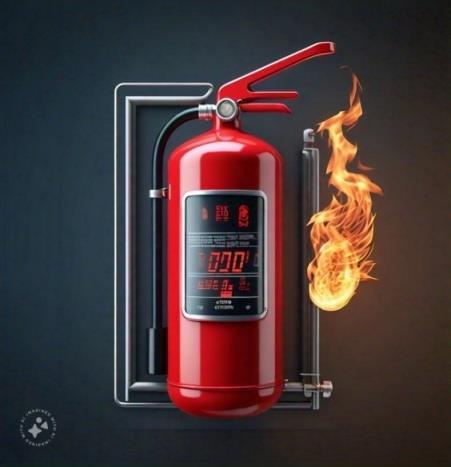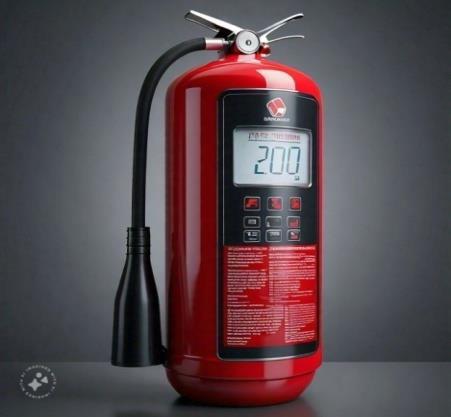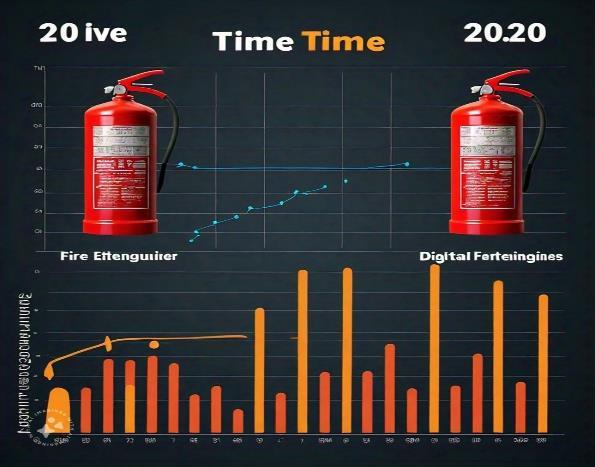
International Research Journal of Engineering and Technology (IRJET) e-ISSN:2395-0056
Volume: 11 Issue: 09 | Sep 2024 www.irjet.net p-ISSN:2395-0072


International Research Journal of Engineering and Technology (IRJET) e-ISSN:2395-0056
Volume: 11 Issue: 09 | Sep 2024 www.irjet.net p-ISSN:2395-0072
Sujithgavaskar S1, Vairamani R2 , A C Mariappan3 ,G Peter packiaraj4
1,2FINAL YEAR B.E MARINE CADET,PSN CET , TIRUNELVELI, TAMIL NADU
3,4 ASSISTANT PROFESSOR,DEPARTMENT OF MARINE ENGINEERING,PSN CET,TIRUNELVELI, TAMIL NADU
The Digital Fire Extinguisher is an intelligent fire suppression system that integrates sensors The system consistsofanetworkofsensorsthatMonitortemperature, smoke,andgaslevels,alertingauthoritiesinreal-time.The AI powered algorithm analysis data to determine the type and size of the fire, selecting the most Effective extinguishing agent and deploying it with precision. The system also provides real time video feed and incident reports, enabling emergency responders to assess the situation Remotely. The Digital Fire Extinguisher aims to reduce fire-related damages, injuries, and Fatalities by providing a swift, efficient, and informed response to fire incident
This innovative system integrates Artificial Intelligence (AI), Computer Vision, and IlotTechnologies to create a cutting-edge fire suppression solution The AI-Powered Digital Fire Extinguisher detects fires through real-time video analysis, identifying potential hazards and Alerting authorities.
The AI algorithm
•Analysisvideofeedtodetectsmoke,flames,andheat
•Classifiesfiretype(electrical,chemical,etc.)andseverity
• Selects optimal extinguishing agent and deployment strategy
• Deploys targeted suppression, minimizing damage and environmentalimpact
• Provides real-time incident reports and video feed for emergencyresponders
Key word: digitalfireextinguisheruseAI
INTRODUCTION
The maritime industry is no stranger to fire-related risks, with vessels carrying Hazardous cargo, fuel, and electrical equipment A single spark can ignite a destructive fire threatening life properly and the environment Traditional fire Suppression methods on ships often rely on manual
activation,water-basedSystems,orchemicalagents,which can be ineffective, damaging, or harmful. Imagine a more advanced solution – a Digital Fire Extinguisher System, specifically Designed for ships, that leverages Artificial Intelligence (AI), sensor technologies, and Optimized extinguishing agents to detect and suppress fires at an earlystage
This Innovative system can be integrated into a vessel’s infrastructure, providing real-time Monitoring, swift response,andminimizeddamage.
By harnessing the power of AI And digital technologies, the Digital Fire Extinguisher System aims to revolutionize fire Safety at sea, protecting lives, cargo, and the marine ecosystem Safety at sea, protecting lives, cargo, and the marineecosystem Types
• Water Extinguishers (class A): Effective against fire involvingpaper,wood,clothingandgarbage
• Foam Extinguishers (Class B): Suitable for fires involvingflammableliquids,suchasOil,gasoline,orpaint.
• Dry Chemical Extinguishers (Class B and C): Effective against fires involving Flammable liquids and electrical equipment.
• Dioxide (CO2) Extinguishers (Class B and C):Ideal for firesinvolvingelectricalEquipmentandflammableliquids
• Halon Extinguishers (Class B and C): Effective against firesinvolvingelectricalEquipmentandflammableliquids, butbeingphasedoutduetoenvironmentalConcerns.
• Wet Chemical Extinguishers (Class K): Designed for kitchenfiresinvolvingcookingOilsandgreases.
Using steps of fire extinguisher
• Identify the type of fire
➢ ClassA(ordinarycombustibles)
➢ ClassB(flammableliquids)

International Research Journal of Engineering and Technology (IRJET) e-ISSN:2395-0056
Volume: 11 Issue: 09 | Sep 2024 www.irjet.net p-ISSN:2395-0072
➢ ClassC(electricalfires)
➢ ClassD(combustiblemetals)
Choose the correct extinguisher
➢ Water(A)
➢ Foam(B)
➢ Drychemical(B,C)
➢ Carbondioxide(B,C)
➢ Halon(B,C)
• Follow the PASS method
P-Pullthesafetypinorring
A-AimtheA-nozzleatthebaseofthefire
S-Pressthehandletorelease extinguishingagent
S–Sweepthenozzlefromsidetoside,coveringtheentire area
• Evacuate and call for help
➢ Alertothersandactivatetheship’sfirealarm
➢ Call for assistance from the ship’s crew or emergency services
• Use additional extinguishers if necessary
➢ If the fire is very large or spreading, use additional extinguishers
•Follow ship-specific procedures
➢ Familiarize yourself with the ship’s fire safety plan and equipment
Location
•Bridge:Nearthehelmornavigationstation
•Engine Room: Near the entrance, on bulkheads, or near machinery
•Galley (Kitchen):Nearcookingappliancesorexitdoors
•Accommodation Areas: In corridors, near stairwells, or outsidecabins
•Cargo Hold:Nearaccesspointsorincargohandlingareas
•Machinery Spaces: Near equipment, such as pumps, generators,orcompressors
•Deck Areas:Nearhatchways,cranes,orwinches
•Lifeboat Stations:Nearemergencyescaperout
Maintenance
Monthly Inspections: Check the extinguisher’s pressure gauge,hose,nozzle,andhandlefordamageorwear.
Annual Maintenance: Inspect the extinguisher’s internal components, clean the agent container, and replace the battery
6-Year Maintenance: Perform a thorough inspection, replace the hose and nozzle and recharge or replace the extinguishingagent.
12-Year Hydrostatic Test: Test the agent container’s integrityandreplaceitifnecessary.
Inspection
Visual Inspection: Check for damage, corrosion or wear ontheexteriorandcomponents.ofthefireextinguisher
Pressure Gauge Inspection: make sure the pressure gaugeiswithintherecommendedlimits.
Weight Inspection: Verify the extinguisher’s weight is withintherecommendedrange.
Tag Inspection: Check the inspection tag for the latest maintenanceandinspectionrecords Digital Features
Automatic Alerts: Receive notifications for maintenance, inspections,orissues.
Remote Monitoring: Track the extinguisher’s status and maintenanceneedsremotely.
Digital Inspection Records: Store and access maintenanceandinspectionrecordsdigitally.



The parts of digital fire extinguisher:
Digital display : shows fire extinguisher status pressureandmaintenancealerts
Sensor : monitor the extinguisher pressure ,temperatureandothervitalsigns
Microcontroller :the brain of the extinguisher processingdataandcontrolleroperations
Alarm: trigger audibleand visual alertsin caseof issuesormaintenanceneed
Pressure gauge : displaystheinternalpressureof theextinguishingagent
Agent container : holds the extinguishing Medium(e.g.,cleanagent,water, orfoam
Hose and nozzle : directstheagentontothe fire
Handle : carriesthefireextinguisherandoperates thenozzle
Inspection tag : track maintenance and inspections
Battery(if applicable): power the digital components
Led indicators(if applicable): show status ,alerts,ormaintenanceneed
The working of fixed fire fighter system on digital in a table format:
COMPONENTS DISCRIPTION
WORKING
Sensors Detects heat, smokeorflames Sends signal to control panel
Controlpanel Receives signal fromsensors Activates alarm and alerts
Actuator Receives signal from control panel Releases firesuppressing agent
Fire -suppressing agent Extinguishes or suppressesfire Discharged through nozzles or pipes
Nozzles/pipes Distributes firesuppressing agent Directed at specific areas orhazards
PowerSupply Provides power tosystem Ensures continuous operation
TIME GRAPH

Fig 3 Time difference between the digital and normal fire extinguisher

International Research Journal of Engineering and Technology (IRJET) e-ISSN:2395-0056
Volume: 11 Issue: 09 | Sep 2024 www.irjet.net p-ISSN:2395-0072
DetectionTime:3minutes(representedby3bars)
AlarmTime:2minutes(representedby2bars)
Discharge Time: 5 minutes (represented by 5 bars)
Total Response Time: 10 minutes(represented by 10bars)
Digital Fire Extinguisher
DetectionTime:<1minute(representedby1bar)
AlarmTime:<1minute(representedby1bar)
Discharge Time: <2 minutes (represented by 2 bars)
Total Response Time: <3 minutes(represented by 3bars)
The control system of a digital fire extinguisher typically include
Microcontroller : the brain of the extinguisher, processingdataandcontrollingoperation
Sensor interface :connects sensor to the microcontrollermonitoringpressure,temperature andothervitalsigns
Alarm and notification system :trigger audible and visual alerts in case of issues or maintenance needs
Pressure control system: regulates the pressure oftheextinguishingagent
Flow control system:managesthe flowrate ofthe agentduringdischarge
Valve control system : opensandclosesthevalve toreleasetheagent
Power management system :manages battery lifeandpowerconsumption
Communication interface: allows for connectivity to building management system or monitoringstation
Software and firmware: controls the extinguisher operationandprovidesupdates
These control systems work the fire extinguisher
Alwaysreadyforuse
Properlymaintained
Functioningcorrectly
Notifiedincaseofissues
Conclusion
The Digital Fire Extinguisher (DFE) revolutionizes fire safety management by integrating AI-powered detection, automatedresponse,andreal-timemonitoring.
Enhanced Safety
1.Rapiddetectionandresponse
2.Reducedfalsealarms
3.Improvedemergencyresponsetimes
Increased Efficiency
1.Automatedmaintenancescheduling
2.Predictiveanalyticsforproactivemaintenance
3.Reduceddowntimeandcosts
This result in enhanced safety reliability and ease of
use



I am pursuing B.E final year marine engineering cadet at PSN College of engineering & technology, tirunelveli, tamilnad
I am pursuing B.E final year marine engineering cadet at PSN College of engineering and technology, tirunelveli, tamilnadu Project guide cum assistant Engineering&technology, Tirunelveli,tamilnadu.also Having15yearsexperience inoilandgasindustries. SpecializationinNDTand Projectguidecumassistant

International Research Journal of Engineering and Technology (IRJET) e-ISSN:2395-0056
Volume: 11 Issue: 09 | Sep 2024 www.irjet.net p-ISSN:2395-0072

ProfessorPSNCollegeof Engineering&technology, Tirunelveli,tamilnaduMEO
Class-IVmarineengineering Andworkedvariescountries